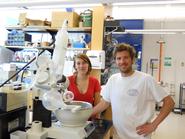
For organic chemists, improvements in methods of synthesizing molecules can make big differences in the time and material that go into the molecule’s synthesis. This summer, Talia Steiman ’12 and Robert Woodworth ’12 are working with Associate Professor of Chemistry Ian Rosenstein on a chemical synthesis that utilizes a unique method to simplify the process and cut down on waste.
The students’ summer research is funded through the Edward and Virginia Taylor Fund for Student/Faculty Research in Chemistry, established in 2008 through a gift from Ted ’46 and Virginia to inspire students interested in chemical research and to facilitate their work with outstanding faculty.
Woodworth explains, “The goal of this project is to do a radical ring expansion reaction with stereocontrol using a chiral auxiliary.” They are working on an innovative method of synthesizing chemical compounds that involves far fewer steps than previous methods.
In organic chemistry, carbon atoms sometimes bond together in rings made up of as few as three atoms. Woodworth and Steiman are attempting to synthesize a molecule with two rings side by side, or a bicyclic molecule. Specifically, they wish to control for the molecule’s 3-D orientation in space so they then end up with only one, very specific arrangement of this molecule. This means the reaction has stereocontrol. As with any other chemical synthesis, this process involves making the target molecule out of other molecules, usually through a series of reactions.
For their experiment, the pair will work with chiral auxiliaries, which are large, bulky molecules that can bind to a starting material. With the chiral auxiliary attached to a reagent, it can be converted into only one arrangement of the target molecule, meaning the reaction has stereocontrol. The chiral auxiliary is a particularly useful tool because once the target molecule is synthesized the auxiliary can be easily removed, leaving the rest of the molecule unchanged.
Rosenstein has published work on this method before, which is groundbreaking for its convenience. Using a chiral auxiliary streamlines the synthesis and maximizes its efficiency. Woodworth and Steiman are helping exemplify this sort of synthesis, furthering the proof behind its reliability. Woodworth is working off of Lydia Rono’s ’11 senior thesis, while Steiman is working from Keith Willner’s ’11 thesis. The two are working toward a similar goal, but using different chiral auxiliaries.
Steiman, a chemistry major, was initially drawn toward this project because she enjoys organic chemistry and was interested in this sort of research. She looks forward to learning new techniques and working with new reagents. Woodworth, a chemistry major with a philosophy minor, wanted to work on research involving a full synthesis from start to finish, and he finds this particular synthesis to be highly interesting. He looks forward to broadening his knowledge of chemistry and furthering his abilities at synthesizing molecules.
Steiman and Woodworth’s project allows them the chance to improve their skills and enhance their knowledge while demonstrating a new and possibly better way of synthesizing certain molecules.
Talia Steiman is a graduate of Poughkeepsie (N.Y.) Day School. Robert Woodworth is a graduate of Middlesex High School (Massachusetts).
